Manuscript accepted on :
Published online on: 06-01-2016
Plagiarism Check: Yes
C. A. Prakash1, J. Parthiban2, R. Balakrishnan3, B. Anandh4, B. Lokesh4
1Department of Oral and Maxillofacial Surgery, Tagore Dental College and Hospital, Chennai 2Department of Oral and Maxillofacial Surgery, Tagore Dental College and Hospital,Chennai,Rathinamangalam, Melakottaiyur Post,Chennai-600127 3Department of Oral and Maxillofacial surgery, Sree Balaji Dental College, Bharath University, Pallikaranai, Chennai-600100 4Department of Oral and Maxillofacial Surgery, Department of Oral and Maxillofacial Surgery, Tagore Dental College and Hospital,Chennai,Rathinamangalam, Melakottaiyur Post,Chennai-600127
DOI : https://dx.doi.org/10.13005/bpj/699
Abstract
Bone Morphogenetic Proteins(BMPs) are a group of growth factors and cytokines known for their ability to induce the formation of bone and cartilage.Originally seven such proteins were discovered.Of these six (BMP2 to BMP7)belong to TGF-B superfamily of proteins.BMP1 is a metalloprotease.Since then thirteen more BMPs have been discovered bringing the total to twenty.MarshallUrist proposed the name’BONEMORPHOGENETIC PROTEIN’ in thescientific literature in ‘Journal of Dental Research’in 1971.BMPs interact with specific receptors on the cell surface referred to as bone morphogenetic protein receptors(BMPRs).BMPs are now produced using recombinant DNA technology.BMP is the most promising osteoinductive protein for bone induction and regeneration. Recombinant human BMP(rhBMP) stimulates osteoblast differentiation in various cells in vitro and induces ectopic bone formation invivo.These formulations have found applications in many disciplines of medicine and dentistry.Orthopaedic and Oral surgery have benefitted greatly from commercially available BMP formulations in the last few years.
Keywords
Bone Morphogenetic Proteins; Growthfactors; Osteoinduction; Reconstruction
Download this article as:| Copy the following to cite this article: Prakash C. A, Parthiban J, Balakrishnan R, Anandh B, Lokesh B. Bone Morphogenetic Proteins - An Update. Biomed Pharmacol J 2015;8(October Spl Edition) |
| Copy the following to cite this URL: Prakash C. A, Parthiban J, Balakrishnan R, Anandh B, Lokesh B. Bone Morphogenetic Proteins - An Update. Biomed Pharmacol J 2015;8(October Spl Edition). Available from: http://biomedpharmajournal.org/?p=3494> |
Introduction
Bone Morphogenetic Proteins (BMPs) are a group of growth factorsand cytokines which induces formation of bone and cartilage. Growth factor is a naturally occurring protein or steroid hormone capable of stimulating cellular growth, cellular differentiation and proliferation.They act as signaling molecules between cells that binds to specific receptors on the target cells.They promote cell differentiation and maturation which varies between growth factors.For example, Bone morphogenetic proteins stimulate bone cell differentiation while fibroblast growth factors and vascular endothelial growth factors stimulate blood vessel differentiation.Recombinant human BMPs (rhBMPs) are widely used in several tissue-engineering products that might serve for the complete regeneration of bone or cartilage.
Discovery of Bmp
Senn, a surgeon from Chicago , described the utility of antiseptic decalcified bone implants in the treatment of osteomyelitis and certain bone deformities.PierreLacroix proposed , that in bone,osteogenin, that might initiate bone growth.MarshallR.Urist made the key discovery that demineralised ,lyophilised segments of bone induced new bone formation. Also proposed the name“ Bone Morphogenetic Protein”.Bone induction is a multistep cascade.The key steps are chemotaxis,mitosis and differentiation.HariReddiindicated morphogens were present in bone matrix, upon which a systematic study was undertaken to isolate and purify putative bone morphogenetic proteins. Reddi laboratory brought out the final purification of bone morphogenetic proteins.JohnWozney& colleagues at Genetics Institute enabled the cloning of BMP’s.Originally seven such proteins were discoveredBMP1 is a metalloprotease.BMP2 to BMP7 belongs to Transforming growth factor beta superfamily of proteins.Thirteen more BMP’s have also been added to this group.
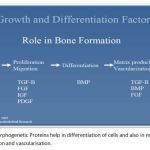 |
Figure 1 |
The Bmp Pathways
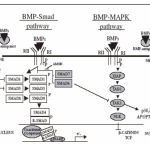 |
Figure 2 |
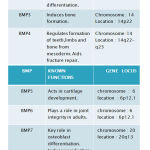 |
Table 1 |
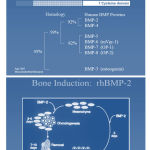 |
Figure 3 |
Discussion
Functions and Applications of Bmps
Bone Morphogenetic Proteins interact with specific receptors on the cell surfaces known as BMP receptors.(BMPRs).The signal transduction through BMPRs result in mobilisation of members of SMAD family of Proteins. The signaling pathways involving BMPs,BMPRs and SMADs are important in the development of heart,CNS and cartilage, as well as post-natal bone development.They play an important role during embryonic development on the embryonic patterning and early skeletal formation. BMP4 and its inhibitors noggin and chordin help regulate polarity of the embryo (i.e. back and front patterning). Disruption of BMP signaling can affect body plan of developing embryo.Mutations in BMPs and their inhibitors (such as sclerostin) are associated with a number of human disorders which affect the skeleton.
Bone Morphogenetic proteins have various applications in Oral and Maxillofacial Surgery.It has been used to reconstruct complete or partially resected mandible.It is used in facial clefts,cleft palate cases,alveolar ridge augmentation,cartilage repair in TMJ and in oral implants.Bone morphogenetic proteins produce osteo induction which helps in inducing osteoblasts to produce native bone or cartilage.
Since the evolution of reconstruction,maxillofacial surgeons could bring back the form and function of the bone resected due to pathologies associated with it.Various forms of reconstruction has since then been practised.From simple reconstruction plates to non vascularised bone grafts to vascularised free flaps,maxillofacial surgeons had options to choose which depended on their skills and the conditions warranted during those surgeries.Post surgicalresection,boneresorption is inevitable which happens with varying degrees except in case of vascularised free flaps.When it comes to free flaps,the technique sensitivity and surgeon’s skill play a key role.In such cases,preventingresorption and inducing bone formation was an able substitute to the technique sensitive free flaps.Bone morphogenetic proteins which are a group of growth factors help in osteo induction that is inducing bone producing osteoblasts to deposit bone at the native site.BMPs help in bone induction,differentiation and regeneration which can either form bone or cartilage.BMP2 to BMP7 belongs to Transforming growth factor beta superfamily of proteins.Thus BMPs prove to be a boon for reconstruction.
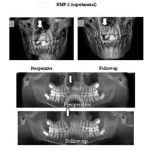 |
Figure 4 |
Courtesy:Improved Healing and Reduced Morbidity with Bone Morphogenic Protein-2 (BMP-2) In Older Patients with Alveolar Cleft Defects
Brian P. Dickinson, MD, Kristy L. Wasson, BA, Catherine O’Hara, BS, Joubin Gabbay, MD, Justin B. Heller, BS, and James P. Bradley, MD
 |
Figure 5 |
Conclusion
Resection of diseased bone and replacement of lost structure to bring back form and function has been practised for many years since the evolution of reconstruction.Formation of new bone and cartilage was not possible with the preliminary form of reconstruction.Non vascularised bone grafts undergo resorption at the recipient site and replacement leading to decreased amount of bone deposition.Vascularised free flaps are technique sensitive and require good surgical acumen which also has its own complicarions such as flap necrosis.In order to bring back the native bone with the same form and function, osteoinduction,differentiation.maturation and regeneration of the recipient bone by Bone morphogenetic proteins play a vital role in reconstruction and are time tested till date.
References
- Abyholm, FE, Bergland, O, Semb, G. Secondary Bone Grafting of Alveolar Clefts. Scand J PlastReconstrSurg 15:127, 1981.
- Alam I, Asahina I, Ohmamiuda K, Enomoto S. Comparative study of biphasic calcium phosphate ceramics impregnated with rhBMP-2 as bone substitutes. J Biomed Mater Res 2001;54:129-38.
- Ashinoff RL, Cetrulo CL Jr, Galiano RD, Dobryansky M, Bhatt KA, Ceradini DJ, Michaels J 5th, McCarthy JG, Gurtner GC. Bone morphogenic protein-2 gene therapy for mandibular distraction osteogenesis. Ann Plast Surg. 2004 Jun;52(6):585-90; discussion 591.
- Boyne, PJ, Sands, NR. Secondary bone grafting of residual alveolar and palatal clefts. J Oral Surg 30:87, 1972.
- Boyne, PJ, Sands, NR. Combined orthodontics/ surgical management of residual alveolar cleft defects. Am J Orthod 70:20, 1976.
- Jingushi S, Urabe K, Okazaki K, et al. Intramuscular bone induction by human recombinant bone morphogenetic protein-2 with beta-tricalcium phosphate as a carrier: in vivo bone banking for muscle-pedicle autograft. J OrthopSci 2002;7:490-4.
- Kenley RA, Yim K, Abrams J, et al. Biotechnology and bone graft substitutes. pharm res 1993;10:1393-1401.
- Mayer, M, Hollinger, J, Ron, E, et al. Maxillary Alveolar Cleft Repair in Dogs Using Recombinant Human Bone Morphogenetic Protein-2 and a Polymer Carrier. PlastReconstrSurg 98:247, 1996.
- Miranda DA, Blumenthal NM, Sorensen RG, Wozney JM, Wikesjo UM. Evaluation of recombinant human bone morphogenetic protein-2 on the repair of alveolar ridge defects in baboons. J Periodontol. 2005 Feb;76(2):210-20.
- Rachmiel A, Aizenbud D, Peled M. Enhancement of bone formation by bone morphogenetic protein-2 during alveolar distraction: an experimental study in sheep. J Periodontol. 2004 Nov;75(11):1524-31
- Sakata-Goto T, Takahashi K, Kiso H, Huang B, Tsukamoto H, et al.(2012) Id2 controls chondrogenesis acting downstream of BMP signaling during maxillary morphogenesis. Bone 50: 69–78..
- Schuckert KH, Jopp S, Teoh SH. Mandibular defect reconstruction using three-dimensional polycaprolactone scaffold in combination with platelet-rich plasma and recombinant human bone morphogenetic protein-2: de novo synthesis of bone in a single case. Tissue Eng Part A 2009;15:493-9.
- Urist MR. Bone: formation by autoinduction. Science1965;150;893-899.
- Valentin-Opran A, Wozney J, Csimma C, Lilly L, Riedel GE. Clinical evaluation of recombinant human bone morphogenetic protein-2. ClinOrthopRelat Res. 2002 Feb;(395):110-20. Review.
- Yasko AW, Lane JM, Rosen V, et al. The healing of segmental bone defects, induced by recombinant human bone morphogenetic protein (rh BMP-2). J Bone Joint Surg1992; 74(5):659-70.
- Zhang H, Sucato DJ, Welch RD. Recombinant human bone morphogenic protein-2-enhanced anterior spine fusion without bone encroachment into the spinal canal: a histomorphometric study in a thoracoscopically instrumented porcine model. Spine. 2005 Mar 1;30(5):512-8.







